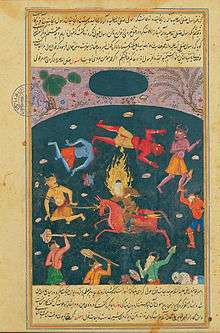
Gold(III) fluoride
Gold(III) fluoride, AuF3, is an orange solid that sublimes at 300 °C. It is a powerful fluorinating agent.
Preparation
AuF3 can be prepared by reacting AuCl3 with F2 or BrF3.
Structure
The crystal structure of AuF3 consists of spirals of square-planar AuF4 units.
References

Die (integrated circuit)
A die in the context of integrated circuits is a small block of semiconducting material, on which a given functional circuit is fabricated. Typically, integrated circuits are produced in large batches on a single wafer of electronic-grade silicon (EGS) or other semiconductor (such as GaAs) through processes such as photolithography. The wafer is cut (“diced”) into many pieces, each containing one copy of the circuit. Each of these pieces is called a die.
There are three commonly used plural forms: dice, dies, and die.
Images

Single NPN bipolar junction transistor die.
Single NPN bipolar junction transistor die.

Close-up of an RGB light-emitting diode, showing the three individual silicon dice.
Close-up of an RGB light-emitting diode, showing the three individual silicon dice.

A small-scale integrated circuit die, with bond wires attached.
A small-scale integrated circuit die, with bond wires attached.

A VLSI integrated-circuit die.
A VLSI integrated-circuit die.

Die (manufacturing)
A die is a specialized tool used in manufacturing industries to cut or shape material mostly using a press. Like molds, dies are generally customized to the item they are used to create. Products made with dies range from simple paper clips to complex pieces used in advanced technology.
Die forming
Forming dies are typically made by tool and die makers and put into production after mounting into a press. The die is a metal block that is used for forming materials like sheet metal and plastic. For the vacuum forming of plastic sheet only a single form is used, typically to form transparent plastic containers (called blister packs) for merchandise. Vacuum forming is considered a simple molding thermoforming process but uses the same principles as die forming. For the forming of sheet metal, such as automobile body parts, two parts may be used: one, called the punch, performs the stretching, bending, and/or blanking operation, while another part, called the die block, securely clamps the workpiece and provides similar stretching, bending, and/or blanking operation. The workpiece may pass through several stages using different tools or operations to obtain the final form. In the case of an automotive component there will usually be a shearing operation after the main forming is done and then additional crimping or rolling operations to ensure that all sharp edges are hidden and to add rigidity to the panel.
FINO
In computer science, FINO (Sometimes seen as "FISH", for First In, Still Here) is a humorous scheduling algorithm. It is an acronym for "First In Never Out" as opposed to traditional "first in first out" (FIFO) and "last in first out" (LIFO) algorithms.
FINO works by withholding all scheduled tasks permanently. No matter how many tasks are scheduled at any time, no task ever actually takes place. This makes FINO extremely simple to implement, but useless in practice. A stateful FINO queue can be used to implement a memory leak.
A mention of FINO appears in the Signetics 25120 write-only memory joke datasheet.
See also
References
FINO (company)
FINO is an Indian financial services company. It mainly caters to people who are not part of the banking network. The company is using technology to reach out to people in rural areas.
References
External links

Jinn
Jinn (Arabic: الجن, al-jinn), also romanized as djinn or anglicized as genies, are supernatural creatures in early Arabian and later Islamic mythology and theology. An individual member of the jinn is known as a jinni, djinni, or genie (الجني, al-jinnī). They are mentioned frequently in the Quran (the 72nd sura is titled Sūrat al-Jinn) and other Islamic texts and inhabit an unseen world, another universe beyond the known universe. The Quran says that the jinn are made of a smokeless and "scorching fire", but are also physical in nature, being able to interact in a tactile manner with people and objects and likewise be acted upon. The jinn, humans, and angels make up the three known sapient creations of God. Like human beings, the jinn can be good, evil, or neutrally benevolent and hence have free will like humans. The shaytan jinn are akin to demons in Christian tradition, but the jinn are not angels and the Quran draws a clear distinction between the two creations. The Quran states in Sūrat al-Kahf (The Cave), Ayah 50, that Iblis (Azazel) is one of the jinn.
Genie (disambiguation)
A genie or jinn is a spiritual creature mentioned in Islamic theology. The English word derives from the Latin genius and is also used for this kind of guardian spirit from ancient Roman religion.
Genie may also refer to:
Companies
Fictional characters
People
Technology
Podcasts:

